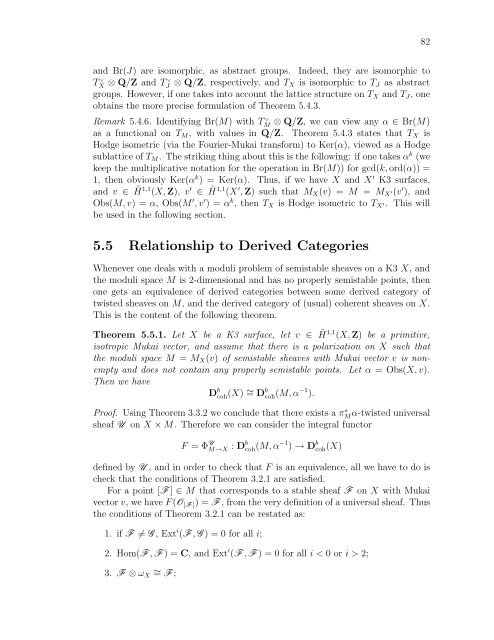derived categories of twisted sheaves on calabi-yau manifolds
derived categories of twisted sheaves on calabi-yau manifolds
derived categories of twisted sheaves on calabi-yau manifolds
Create successful ePaper yourself
Turn your PDF publications into a flip-book with our unique Google optimized e-Paper software.
and Br(J) are isomorphic, as abstract groups. Indeed, they are isomorphic to<br />
T ∨<br />
X<br />
⊗ Q/Z and T ∨<br />
J ⊗ Q/Z, respectively, and TX is isomorphic to TJ as abstract<br />
groups. However, if <strong>on</strong>e takes into account the lattice structure <strong>on</strong> TX and TJ, <strong>on</strong>e<br />
obtains the more precise formulati<strong>on</strong> <str<strong>on</strong>g>of</str<strong>on</strong>g> Theorem 5.4.3.<br />
Remark 5.4.6. Identifying Br(M) with T ∨<br />
M ⊗ Q/Z, we can view any α ∈ Br(M)<br />
as a functi<strong>on</strong>al <strong>on</strong> TM, with values in Q/Z. Theorem 5.4.3 states that TX is<br />
Hodge isometric (via the Fourier-Mukai transform) to Ker(α), viewed as a Hodge<br />
sublattice <str<strong>on</strong>g>of</str<strong>on</strong>g> TM. The striking thing about this is the following: if <strong>on</strong>e takes αk (we<br />
keep the multiplicative notati<strong>on</strong> for the operati<strong>on</strong> in Br(M)) for gcd(k, ord(α)) =<br />
1, then obviously Ker(αk ) = Ker(α). Thus, if we have X and X ′ K3 surfaces,<br />
and v ∈ ˜ H1,1 (X, Z), v ′ ∈ ˜ H1,1 (X ′ , Z) such that MX(v) = M = MX ′(v′ ), and<br />
Obs(M, v) = α, Obs(M ′ , v ′ ) = αk , then TX is Hodge isometric to TX ′. This will<br />
be used in the following secti<strong>on</strong>.<br />
5.5 Relati<strong>on</strong>ship to Derived Categories<br />
Whenever <strong>on</strong>e deals with a moduli problem <str<strong>on</strong>g>of</str<strong>on</strong>g> semistable <str<strong>on</strong>g>sheaves</str<strong>on</strong>g> <strong>on</strong> a K3 X, and<br />
the moduli space M is 2-dimensi<strong>on</strong>al and has no properly semistable points, then<br />
<strong>on</strong>e gets an equivalence <str<strong>on</strong>g>of</str<strong>on</strong>g> <str<strong>on</strong>g>derived</str<strong>on</strong>g> <str<strong>on</strong>g>categories</str<strong>on</strong>g> between some <str<strong>on</strong>g>derived</str<strong>on</strong>g> category <str<strong>on</strong>g>of</str<strong>on</strong>g><br />
<str<strong>on</strong>g>twisted</str<strong>on</strong>g> <str<strong>on</strong>g>sheaves</str<strong>on</strong>g> <strong>on</strong> M, and the <str<strong>on</strong>g>derived</str<strong>on</strong>g> category <str<strong>on</strong>g>of</str<strong>on</strong>g> (usual) coherent <str<strong>on</strong>g>sheaves</str<strong>on</strong>g> <strong>on</strong> X.<br />
This is the c<strong>on</strong>tent <str<strong>on</strong>g>of</str<strong>on</strong>g> the following theorem.<br />
Theorem 5.5.1. Let X be a K3 surface, let v ∈ ˜ H 1,1 (X, Z) be a primitive,<br />
isotropic Mukai vector, and assume that there is a polarizati<strong>on</strong> <strong>on</strong> X such that<br />
the moduli space M = MX(v) <str<strong>on</strong>g>of</str<strong>on</strong>g> semistable <str<strong>on</strong>g>sheaves</str<strong>on</strong>g> with Mukai vector v is n<strong>on</strong>empty<br />
and does not c<strong>on</strong>tain any properly semistable points. Let α = Obs(X, v).<br />
Then we have<br />
D b coh(X) ∼ = D b coh(M, α −1 ).<br />
Pro<str<strong>on</strong>g>of</str<strong>on</strong>g>. Using Theorem 3.3.2 we c<strong>on</strong>clude that there exists a π∗ Mα-<str<strong>on</strong>g>twisted</str<strong>on</strong>g> universal<br />
sheaf U <strong>on</strong> X × M. Therefore we can c<strong>on</strong>sider the integral functor<br />
F = Φ U M→X : D b coh(M, α −1 ) → D b coh(X)<br />
defined by U , and in order to check that F is an equivalence, all we have to do is<br />
check that the c<strong>on</strong>diti<strong>on</strong>s <str<strong>on</strong>g>of</str<strong>on</strong>g> Theorem 3.2.1 are satisfied.<br />
For a point [F ] ∈ M that corresp<strong>on</strong>ds to a stable sheaf F <strong>on</strong> X with Mukai<br />
vector v, we have F (O[F]) = F , from the very definiti<strong>on</strong> <str<strong>on</strong>g>of</str<strong>on</strong>g> a universal sheaf. Thus<br />
the c<strong>on</strong>diti<strong>on</strong>s <str<strong>on</strong>g>of</str<strong>on</strong>g> Theorem 3.2.1 can be restated as:<br />
1. if F = G , Ext i (F , G ) = 0 for all i;<br />
2. Hom(F , F ) = C, and Ext i (F , F ) = 0 for all i < 0 or i > 2;<br />
3. F ⊗ ωX ∼ = F ;<br />
82
















